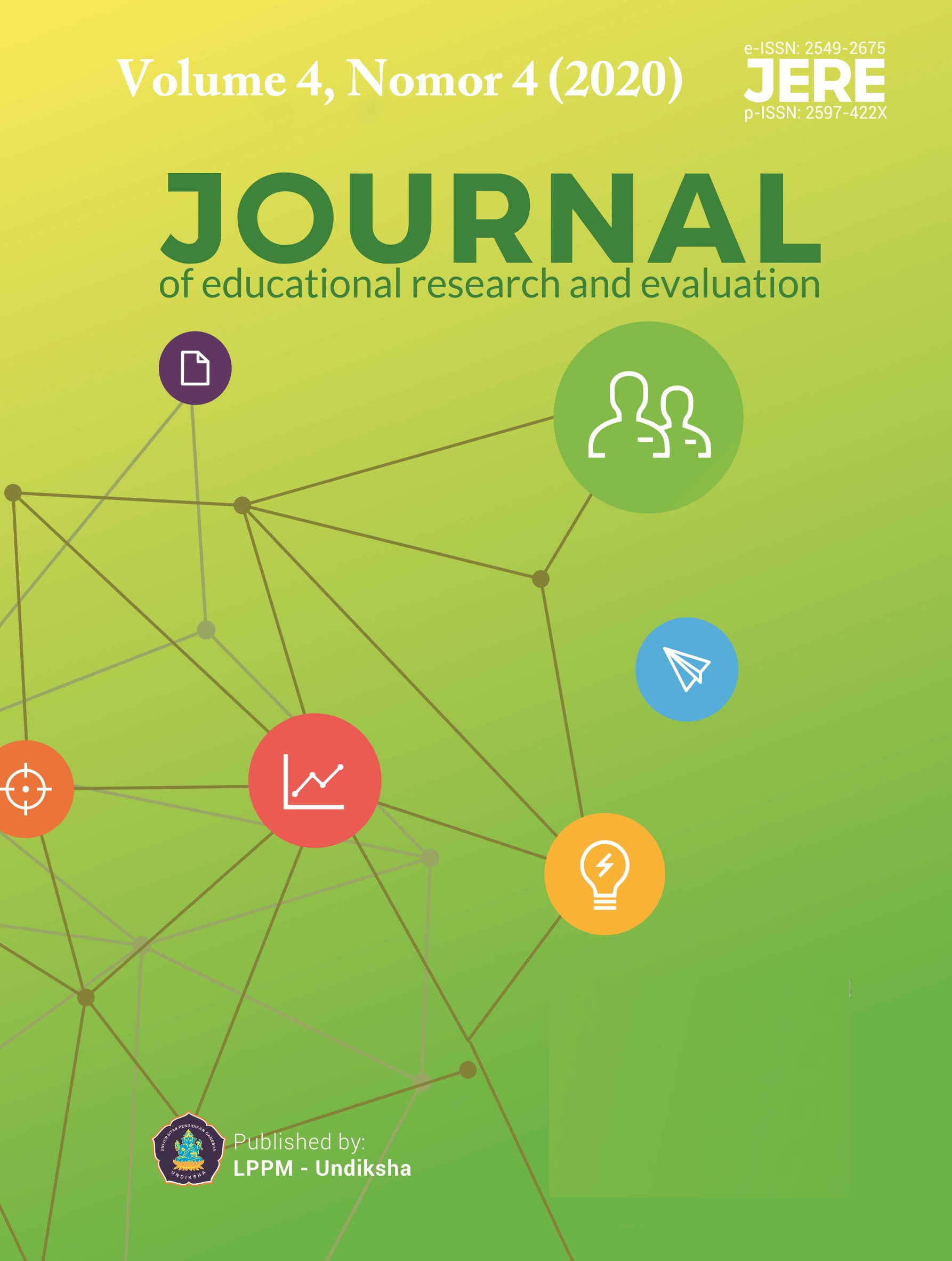A Comparative Study of The Students’ Critical Reading Competency on High Order Thinking Items in A Junior High School
DOI:
https://doi.org/10.23887/jere.v4i4.28011Abstract
This study aims to analyze and describe the students’ reading competencies and comparing simultaneously the students reading competencies on high order thinking items across classes, text genres, and reading indicators. The design implemented was descriptive in order to answer the first research question and comparative research in order to answer the second research questions. The instrument used for data collection was reading competency test. The data were then analyzed descriptively and inferentially by implementing a parametric statistic, namely: central tendency measures; measures of dispersion; and simultaneous comparison. The present study was applied one-way ANOVA as the inferential analysis. The result showed, the significant value of one-way ANOVA on the students Reading Competency was 0.75. The significant figure was higher than 0.05. As a result, the students reading competency in high order thinking items was not significant. Therefore, the null hypothesis was accepted. It can be drawn a conclusion that the students reading competencies on high-order-thinking items across classes, text genres, and reading indicators are in below average.
References
Abdel Halim, S. M. (2011). Improving EFL majors’ critical reading skills and political awareness: A proposed translation program. International Journal of Educational Research, 50(5–6), 336–348. https://doi.org/10.1016/j.ijer.2011.11.003
Akın, F., Koray, Ö., & Tavukçu, K. (2015). How Effective is Critical Reading in the Understanding of Scientific Texts? Procedia - Social and Behavioral Sciences, 174, 2444–2451. https://doi.org/10.1016/j.sbspro.2015.01.915
Albeckay, E. M. (2014). Developing Reading Skills through Critical Reading Programme amongst Undergraduate EFL Students in Libya. Procedia - Social and Behavioral Sciences, 123, 175–181. https://doi.org/10.1016/j.sbspro.2014.01.1412
Ary, D., C., J. L., Sorensen, C., & Razavieh, A. (2010). Introduction to Research in Education (English). Nelson Education, Ltd.
Belet, Ş. D., & Dal, S. (2010). The use of storytelling to develop the primary school student’s critical reading skill: The primary education pre-service teacher’s opinions. Procedia - Social and Behavioral Sciences, 9, 1830–1834. https://doi.org/10.1016/j.sbspro.2010.12.409
Cano, J., & Martinez, C. (1991). The relationship between cognitive performance and critical thinking abilities among selected agricultural education students. Journal of Agricultural Education, 32(1), 24–29. http://pubs.aged.tamu.edu/jae/pdf/vol32/32-0124.pdf
Cresswell, J. W. (2012). Educational Research. Pearson.
Delgadova, E. (2015). Reading Literacy as One of the Most Significant Academic Competencies for the University Students. Procedia - Social and Behavioral Sciences, 178(November 2014), 48–53. https://doi.org/10.1016/j.sbspro.2015.03.145
Din, M. (2020). Evaluating university students’ critical thinking ability as reflected in their critical reading skill: A study at bachelor level in Pakistan. Thinking Skills and Creativity, 35(January), 100627. https://doi.org/10.1016/j.tsc.2020.100627
Doležalová, J. (2015). Competencies of Teachers and Student Teachers for the Development of Reading Literacy. Procedia - Social and Behavioral Sciences, 171, 519–525. https://doi.org/10.1016/j.sbspro.2015.01.156
Duran, E., & Yalçintaş, E. (2015). Review of the Critical Reading Education in the Primary Schools1. Procedia - Social and Behavioral Sciences, 174, 1560–1566. https://doi.org/10.1016/j.sbspro.2015.01.788
Frankel, K. K., Becker, B. L., Rowe, M. W., & Pearson, P. D. (2016). From “what is reading?” to what is literacy? Journal of Education, 196(3), 7–17. https://doi.org/10.1177/002205741619600303
Furchan, A. (1990). Pengantar penelitian Dalam Pendidikan. Usaha Nasional.
Gall, M. D., & Borg, W. R. (2007). Educational Research: An introduction. Longman.
Glass, G., & Hopkins, D. (1984). Statistical methods in Education and Psychology. Prentice-Hall Inc.
Harrison, C. (2004). Understanding Reading Development. Sage Publications.
Hashimoto, T., Hayashi, Y., & Seta, K. (2019). Metacognitive inference activity support by visualizing eye-movement graph during critical reading. Procedia Computer Science, 159, 1995–2004. https://doi.org/10.1016/j.procs.2019.09.372
Hinkle, D. E., Wiersma, W., & Jurs, S. G. (1979). Applied Statistics for the Behavioral Sciences (1st ed.). Houghton Mifflin Company.
Karadağ, R. (2014). Primary School Teacher Candidates’ Views towards Critical Reading Skills and Perceptions of their Competence. Procedia - Social and Behavioral Sciences, 152, 889–896. https://doi.org/10.1016/j.sbspro.2014.09.339
Kemendikbud. (2013). Kerangka Dasar Kurikulum 2013. Kementerian Pendidikan dan Kebudayaan.
Kim, M. C., & Hannafin, M. J. (2011). Scaffolding Problem Solving in Technology-enhanced Learning Environments (TELEs): Bridging Research and Theory with Practice. Computers and Education, 56(2), 403–417. https://doi.org/10.1016/j.compedu.2010.08.024
Lai, E. R. (2011). Critical thinking: A literature review. Pearson’s Research Reports, 6(1), 40–41. http://images.pearsonassessments.com/images/tmrs/CriticalThinkingReviewFINAL.pdf.
Latifa, N. (2018). Teaching Narrative Text by Using Preview, Question, Read, State, and Test (PQRST) Technique. English Education Journal (EEJ), 9(2), 243–260. https://repository.ar-raniry.ac.id/id/eprint/5351/
Ningsih, S. (2016). Guided Writing to Improve the Students ’ Writing Ability of Junior High School Students. EFL Journal, 1(2), 129–140.
OECD. (2013). PISA 2012 Assessment and Analytical Framework: Mathematics, Reading, Science, Problem Solving and Financial Literacy. OECD Publishing.
Pratiwi, I. (2019). Efek Program Pisa Terhadap Kurikulum Di Indonesia. Jurnal Pendidikan Dan Kebudayaan, 4(1), 51–71. https://doi.org/10.24832/jpnk.V4i1.115
Rogiers, A., Van Keer, H., & Merchie, E. (2020). The profile of the skilled reader: An investigation into the role of reading enjoyment and student characteristics. International Journal of Educational Research, 99(1). https://doi.org/10.1016/j.ijer.2019.101512
Schleicher, A. (2018). PISA 2018 Insight and Interpretation. Organization for Economic Co-operation and Development.
Sugiyono. (2014). Metode Penelitian Pendidikan Pendekatan Kuantitatif, Kualitatif, dan R&D. Alfabeta.
Wilson, K. (2016). Critical reading, critical thinking: Delicate scaffolding in English for Academic Purposes (EAP). Thinking Skills and Creativity, 22, 256–265. https://doi.org/10.1016/j.tsc.2016.10.002
Downloads
Published
How to Cite
Issue
Section
License
Authors who publish with the Journal of Evaluation and Research in Education (JERE) agree to the following terms:
- Authors retain copyright and grant the journal the right of first publication with the work simultaneously licensed under a Creative Commons Attribution License (CC BY-SA 4.0) that allows others to share the work with an acknowledgment of the work's authorship and initial publication in this journal.
- Authors are able to enter into separate, additional contractual arrangements for the non-exclusive distribution of the journal's published version of the work (e.g., post it to an institutional repository or publish it in a book), with an acknowledgment of its initial publication in this journal.
- Authors are permitted and encouraged to post their work online (e.g., in institutional repositories or on their website) prior to and during the submission process, as it can lead to productive exchanges, as well as earlier and greater citation of published work. (See The Effect of Open Access)











